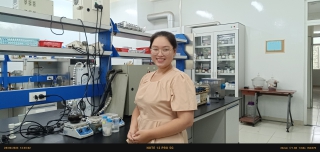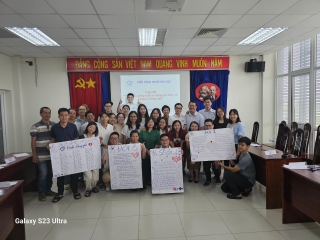Laboratory of Agriculture chemistry
25/02/2021


Information about the Lab of Agricultural Chemistry
Laboratory of Agriculture chemistry
1. General Information of the Department:
- Name of Lab: Laboratory of Agriculture chemistry
- Vietnamese name: Phòng Hóa Nông.
- Head of Department: PhD. Pham Cao Thanh Tung
- Number of staff: 07
- Communications: Chemical Technology Institute
No. 1A, TL29 Street, Thanh Loc Ward, District 12, HCMC
2. Equipment, machinery: Basic equipment of the laboratory
3. Main research direction: Functional nanostructured materials
Porous structured zeolite material used as molecular sieve
Zeolitic aluminophosphate, a microporous 3D material, with an average pore size of ~ 0.38 nm, is used in molecular rails separating CO2. The CO / CH4 separation for pre-flammable processes is of concern in environmental protection and energy efficiency. The zeolitic aluminophosphate membrane is synthesized by an environmentally friendly method using a low cost kaoline foam substrate, with high CO2 / CH4 separation efficiency.

Figure 1. (a, b) The ability to separate CO2 / CH4 of AlPO-18 membrane in terms of CO2 permeability (open square), CH4 permeability (open circle) and separation coefficient (circular shape), relative to the temperature and duration of the membrane; and (c, d) SAPO-34 membrane.
Photoluminescent nanomaterials applied to mciroLED lamps emit white light
Quantum dots perovskite and hexaflouride are used in white light emitting diodes. The hexaflouride material with a size of about 150 nm, well dispersed in isopropanol solvent, absorbs light from UV to blue (450 nm) and high intensity red (630 nm) light (Figure 2). . Quantum dots perovskite CsPb (Cl, Br, I) 3 with size about 3 nm, absorbs light well from UV to 500 nm, fluorescence with different colors blue, green and red.

Figure 2. (a) FESEM image of K2SiF6: Mn4 + (KSFM); (b) Optical diagram of KSFM and light diffusion phenomenon of nano KSFM in alcohol solvent under 365 nm excitation light; (c) TEM image of QDs CsPbI3 and (d) Optical diagram of samples CsPbCl3, CsPbBr3, CsPbBrI2, CsPbI3, and corresponding illumination under 365 nm excitation light
InGaN components are microscopic in nanowire structure
LED lights are considered as the lighting technology of the 21st century due to low energy consumption, less heat generation and environmental friendliness. Display technology using 10-100 µm LED display technology (microLED display) will be the next display technology of LCD and OLED displays. Technology using microLED displays has many advantages such as high color rendering (Color Rendering Index), ultra-wide viewing angle, fast response time, high brightness and long life. Full color and white light emitting LEDs are based on the InGaN (shell) / AlGaN (core) nanofiber structure, developed on a silicon substrate using the plasma-assisted Molecular Beam Epitaxy method. Figure 3 shows the luminous spectrum of a 50 µm nanoscale structure LED.
 |
 |
Figure 3. (a) Structure of LED nanowire with 10 layers InGaN / AlGaN quantum well; (b) FESEM figure of 45 ° study of the nanowires; (c) Schematic of μLEDs and electrodes; (d) The luminous spectrum of InGaN / AlGaN quantum-wells at room temperature.
Most view
Recruitment and appointment of professional positions of public employees in 2023
Decision No.: 04/QD-CNHH dated January 9, 2024
Public announcement of State budget estimates-2023
Decision No. 12/ QĐ-CNHH, Date: 30/01/2024 To publicize the State budget estimates-2023
Public announcement of State budget estimates - 2022
Decision No. 09/ QĐ-CNHH, Date: 29/01/2024 To publicize the State budget estimates-2022
Decision to establish the Academy-level Doctoral Thesis Evaluation Council
Decision No. 1388/QD-HVKHCN On the establishment of the Academy-level Doctoral Thesis Evaluation Council
Gender Equality: "Gender does not determine ability and qualifications"
Responding to the program: "Month of action for gender equality and preventing and responding to gender-based violence in 2023"
4 2 7 5 3 8 3 6
Today
30
Yesterday
358
Week
0
Month
9,234







